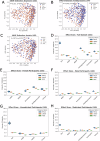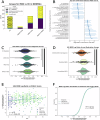Medication use is associated with distinct microbial features in anxiety and depression
- PMID: 39794490
- PMCID: PMC12092254
- DOI: 10.1038/s41380-024-02857-2
Medication use is associated with distinct microbial features in anxiety and depression
Abstract
This study investigated the relationship between gut microbiota and neuropsychiatric disorders (NPDs), specifically anxiety disorder (ANXD) and/or major depressive disorder (MDD), as defined by Diagnostic and Statistical Manual of Mental Disorders (DSM)-IV or V criteria. The study also examined the influence of medication use, particularly antidepressants and/or anxiolytics, classified through the Anatomical Therapeutic Chemical (ATC) Classification System, on the gut microbiota. Both 16S rRNA gene amplicon sequencing (16S) and shallow shotgun sequencing (WGS) were performed on DNA extracted from 666 fecal samples from the Tulsa-1000 and Neurocomputational Mechanisms of Affiliation and Personality Study Center for Biomedical Research Excellence (NeuroMAP CoBRE) cohorts. The results highlight the significant influence of medication use; antidepressant use is associated with significant differences in gut microbiota beta diversity and has a larger effect size than NPD diagnosis. Next, specific microbes were associated with ANXD and MDD, highlighting their potential for non-pharmacological intervention. Finally, the study demonstrated the capability of Random Forest classifiers to predict diagnoses of NPD and medication use from microbial profiles, suggesting a promising direction for the use of gut microbiota as biomarkers for NPD. Though the effect sizes were larger in females than males, similar trends emerged for both sexes. These findings encourage future research on the gut microbiota's role in NPD and its interactions with pharmacological treatments.
© 2025. The Author(s).
Conflict of interest statement
Competing interests: DM is a consultant for, and has equity in, BiomeSense, Inc. ME is the chief science officer and has equity at Innovate Phytoceuticals Inc. He is a scientific advisor and holds equity at Melius Microbiomics Inc. BWD has received research support from Beckley PsyTech, Boehringer Ingelheim, Compass Pathways, NIMH, Otsuka, Reunion Neuroscience, and the Usona Institute, and has served as a consultant for Biohaven, Cerebral Therapeutics, Myriad Neuroscience, NRx Pharmaceuticals, and Otsuka. RK-D is an inventor on key patents in the field of Metabolomics and holds equity in Metabolon. In addition, she holds patents licensed to Chymia LLC and PsyProtix with royalties and ownership. PD (of the AGMP consortium) is an advisor and holds equity in Cybele and Sirenas and a Scientific co-founder, advisor and holds equity to Ometa, Enveda, and Arome with prior approval by UC San Diego. PD also consulted for DSM animal health in 2023. RK is a scientific advisory board member, and consultant for BiomeSense, Inc., has equity and receives income. He is a scientific advisory board member and has equity in GenCirq. He is a consultant and scientific advisory board member for DayTwo, and receives income. He has equity in and acts as a consultant for Cybele. He is a co-founder of Biota, Inc., and has equity. He is a cofounder of Micronoma, and has equity and is a scientific advisory board member. The terms of these arrangements have been reviewed and approved by the University of California, San Diego in accordance with its conflict of interest policies. The companies listed here had no role in the design and conduct of the study; collection, management, analysis, and interpretation of the data; preparation, review, or approval of the paper; and decision to submit the paper for publication.
Figures





Update of
-
Medication Use is Associated with Distinct Microbial Features in Anxiety and Depression.bioRxiv [Preprint]. 2024 Mar 19:2024.03.19.585820. doi: 10.1101/2024.03.19.585820. bioRxiv. 2024. Update in: Mol Psychiatry. 2025 Jun;30(6):2545-2557. doi: 10.1038/s41380-024-02857-2. PMID: 38562901 Free PMC article. Updated. Preprint.
References
-
- Morais LH, Schreiber HL, Mazmanian SK. The gut microbiota–brain axis in behaviour and brain disorders. Nat Rev Microbiol. 2020;19:241–55. - PubMed
MeSH terms
Substances
Grants and funding
- R01 AG046171/AG/NIA NIH HHS/United States
- U19 AG063744/AG/NIA NIH HHS/United States
- 5U19AG063744/U.S. Department of Health & Human Services | NIH | National Institute on Aging (U.S. National Institute on Aging)
- U19AG063744/U.S. Department of Health & Human Services | NIH | National Institute on Aging (U.S. National Institute on Aging)
- RF1 AG059093/AG/NIA NIH HHS/United States
LinkOut - more resources
Full Text Sources
Medical
Research Materials

